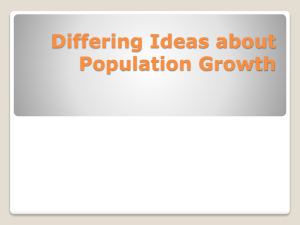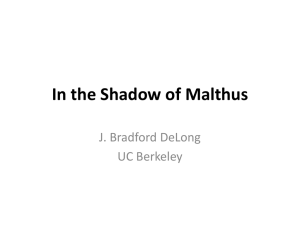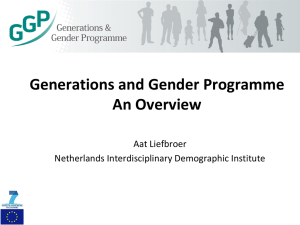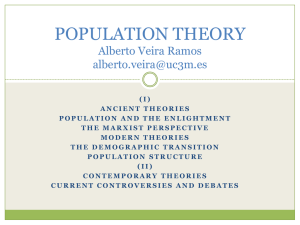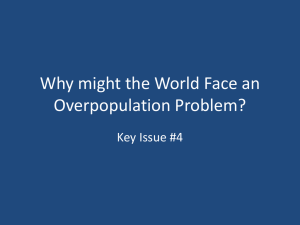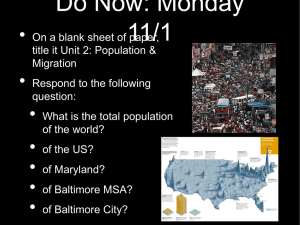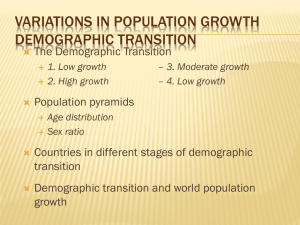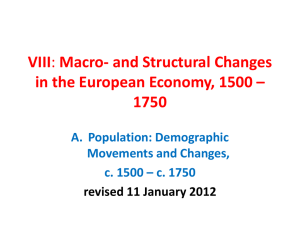Chapter 3
advertisement
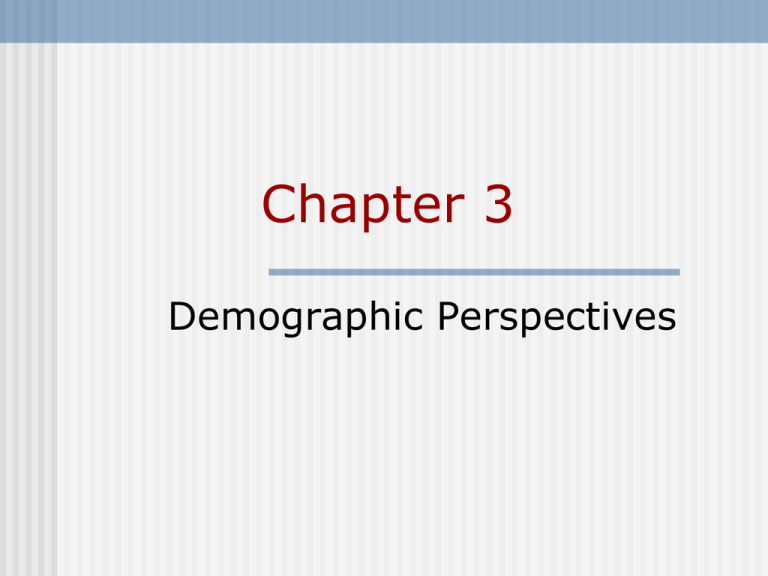
Chapter 3 Demographic Perspectives Developing a Demographic Perspective • Two Questions: 1. What are the causes of population growth (or, at least, population change)? 2. What are the consequences of population growth or change? Chapter Outline • Premodern Population Doctrines Terms demographic perspective (p. 67) a way of relating basic information to theories about how the world operates demographically Doctrine (p. 67) a principle laid down as true and beyond dispute a system of assumptions, accepted principles, and rules of procedure devised to analyze, predict, or otherwise explain a set of phenomena Theory (p. 67) Premodern Doctrines Date Demographic Perspective ~1,300 bc Genesis—“Be fruitful and multiply.” ~500 bc ~360 bc ~340 bc Confucius—Governments should maintain balance between population and resources. Plato—population quality more important than quantity Aristotle—population should be limited; abortion might be appropriate. Premodern Doctrines Date ~100 bc ~400 a.d. Demographic Perspective Cicero—population growth necessary to maintain the Roman Empire. St. Augustine—abstinence is preferred way to deal with sexuality; second best is to marry and procreate. The Renaissance in Europe began with •Trade with the Muslim Ottoman Empire •The receding of the Black Plague •Growth of cities Premodern Doctrines ~1280 a.d. St. Thomas Aquinas—celibacy is not better than marriage and procreation. ~1380 a.d. Ibn Khaldun—population growth increases occupational specialization and raises incomes. Procreation stimulated by high hopes and heightening of animal energies. Columbian Exchange (p. 72) the exchange of food, products, people, and diseases between Europe and the Americas as a result of explorations by Columbus and others Mercantilism (p. 72) the view that a nation’s wealth depended on its store of precious metals and that generating this kind of wealth was facilitated by population growth Physiocratic (p. 73) the philosophy that the real wealth of a nation is in the land, not in the number of people Premodern Doctrines Date Demographic Perspective ~1500– 1800 Mercantilism—increasing national wealth depends on a growing population that can stimulate trade. ~1700– 1800 Physiocrats—population size depends upon the wealth of the land, which is stimulated by free trade. Mercantilism Supported by the demographic analysis of John Graunt, William Petty and Edmund Halley. Graunt’s work was based on the Bills of Mortality that became the first know statistical analysis of demographic data. Sussmilch – Improvements in agriculture and industry would postpone overpopulation into the future. Chapter Outline • The Prelude To Malthus • Major Events/periods preceding the publication of Malthus’s book on population Columbian Exchange Enlightenment French Revolution Modern Theories Date Demographic Perspective 1798 Malthus—population grows exponentially, food supply grows arithmetically; poverty is the result in the absence of moral restraint. ~1800 Neo-Malthusian—birth control measures are appropriate checks to population growth. ~1844 Marxian—each society has its own law of population that determines consequences of population growth; poverty is not the natural result of population growth. Influences on Malthus • The writings of the Marquis de Condorcet were an important precursor to Malthus’s Essay on Population. • William Godwin – Scientific progress would increase the amount of food far beyond what was possible at the time. Malthus’s Principle of Population The essential element was that population grew geometrically while food increased arithmetically Malthus’s Principle of Population • checks to growth Factors that have kept population growth from reaching its biological potential for covering the earth with human bodies. Checks to growth • positive checks Causes of mortality. – War, pestilence, famine • preventive checks All possible means of birth control, including abstinence, contraception, and abortion. Malthus’s Principle of Population • moral restraint According to Malthus, the only acceptable means of preventing a birth: postpone marriage, remaining chaste in the meantime. • Means of subsistence – Ultimate check to growth Malthus’s idea about moral restraint Postpone Marry marriage only when you can afford children Chapter Outline • The Prelude To The Demographic Transition Theory • The Theory Of The Demographic Transition • The Demographic Transition Is Really A Set Of Transitions The Malthusian Perspective • Malthus argued that people have a natural urge to reproduce, and the increase in the food supply cannot keep up with population growth. • The major consequence of population growth, according to Malthus, is poverty. • Within that poverty is the stimulus for action that can lift people out of misery. Critiques of Malthus Assertion that food production could not keep up with population growth. Conclusion that poverty was an inevitable result of population growth. Belief that moral restraint was the only acceptable preventive check. The Marxian Perspective • Each society at each point in history has its own law of population that determines population growth. For capitalism, the consequences are overpopulation and poverty. For socialism, population growth is readily absorbed by the economy with no side effects. Marx on Malthus • Marx Malthus's "natural law of population” only natural in capitalist societies Poverty is the result of the evils off social organization. John Stuart Mill • Basic thesis was that the standard of living is a major determinant of fertility levels. • The ideal state is that in which all members of a society are economically comfortable. • Fear of slipping socially was a motivation to limit fertility • People do not “Propagate like Swine”87 Arsène Dumont • Late 19th century French demographer who felt he discovered a new principle of population called “social capillarity”. The desire of people to rise on the social scale, to increase their individuality as well as their personal wealth. • To ascend the social hierarchy requires that sacrifices be made. Émile Durkheim • Based an entire social theory on the consequences of population growth. • Population growth leads to greater societal specialization, because the struggle for existence is more acute when there are more people. • View of population growth similar to Khaldun. Modern Theories Date Demographic Perspective 1945 Demographic transition in its original form—the process where a country moves from high birth and death rates to low birth and death rates. 1962 Earliest studies suggesting the need to reformulate demographic transition theory. 1963 Demographic response made by individuals to population pressures is determined by the means available to them to respond; causes and consequences of population change are intertwined. Demographic change and response First response people will likely make to the population growth resulting from a decline in mortality is to work harder. Second response would be to migrate. Theory of the Demographic Transition • Emphasizes the importance of economic and social development. • Leads first to a decline in mortality and then to a commensurate decline in fertility. • Based on the experience of the developed nations, and derived from the modernization theory. 1928 – Warren Thompson Group C Group B Group A 1945 - Frank Notestein High Potential Growth Transitional Incipient Decline Modern Theories Date Demographic Perspective 1968 Easterlin relative cohort size hypothesis — successively larger young cohorts put pressure on young men’s relative wages, forcing them to make a tradeoff between family size and overall well-being. 1971– present Decomposition of the demographic transition into its separate transitions—mortality, fertility, age, migration, urbanization, and family and household. Easterlin Relative Cohort Size Hypothesis • The standard of living you experience in late childhood is the base from which you evaluate your chances as an adult. • If you can improve your income as an adult compared to your childhood level, you are more likely to marry early and have several children. Modernization Theory • Macro-level theory that sees human actors as being buffeted by changing social institutions. Individuals did not deliberately lower their risk of death to precipitate the modern decline in mortality. Society wide increases in income and improved public health infrastructure brought about this change. Demographic Transition: A Set of Transitions 1. Mortality transition -shift from deaths at younger ages due to disease to deaths at older ages due to degenerative diseases. 2. Fertility transition- the shift from natural (and high) to controlled (and low) fertility. Demographic Transition: A Set of Transitions 3. Age transition- social and economic reactions as societies adjust to constantly changing age distributions. 4. Migration transition - Growth in the number of young people in rural areas will lead to an oversupply of young people looking for jobs, which encourages people to leave in search of economic opportunity. Demographic Transition: A Set of Transitions 5. Urban transition - begins with migration from rural to urban areas and morphs into urban “evolution” as most humans are born in, live in, and die in cities. 6. Family and household transition brought about by structural changes that accompany longer life, lower fertility, an older age structure, and urban instead of rural residence.



